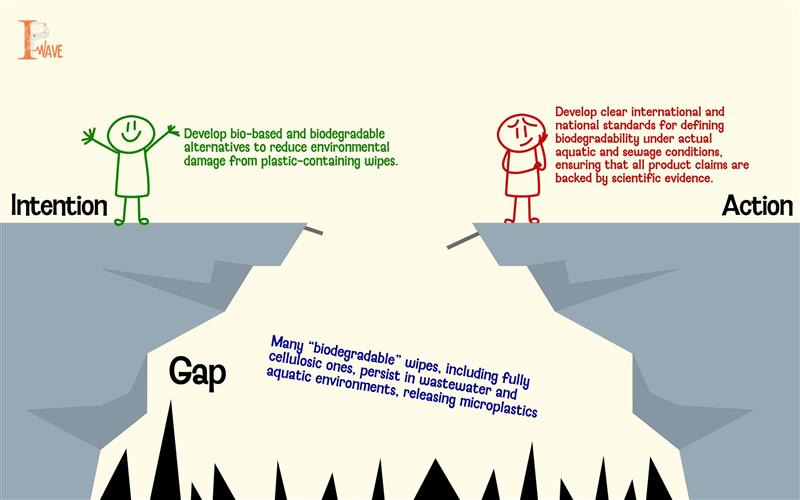Wet Wipes: A Daily Convenience With a Hidden Pollution Problem
Wiping our faces with a cool, scented wet wipe is one of the most instantly refreshing things we can do on a hot summer day. These products provide a momentary feeling of relief and cleanliness. However, what looks like soft cotton is frequently a non-biodegradable fabric because the fibers are woven with synthetic plastic polymers, which prevents them from breaking down in the environment.
The Market Is Changing From Plastic to "Biodegradable"
In recent years, there has been an increase in public awareness of the harm that flushing wet wipes containing plastic causes to the environment. The market for "biodegradable" or bio-based substitutes has increased as a result. Nevertheless, studies reveal that many of these products continue to contribute to environmental pollution as microplastics in rivers and wastewater systems, even in spite of such marketing claims.
Microplastics — plastic particles less than 5 mm — are an increasing concern in aquatic environments, where they can enter food chains and carry harmful contaminants.
During the COVID-19 pandemic, demand for single-use, multipurpose wet wipes increased dramatically worldwide.
Global market: USD 27,072.3 million (2022)
India’s market: USD 2,093.8 million (2022), projected to reach USD 3,434.2 million by 2030.
Share: India accounted for 7.7% of global wet wipe sales in 2022, making it the fastest-growing market in the Asia-Pacific region.
Categories: Baby wipes, facial & cosmetic wipes, hand & body wipes, intimate wipes, flushable wet wipes, household/disinfectant/cleaning wipes.
Cellulose Wipes Are Not Without Problems
Even cellulose-based wet wipes, which are made from cotton, rayon, or wood pulp, can linger in sewer systems and the environment, according to a 2023 study by Thomas Allison et al. Although cellulose fibers physically break apart, normal environmental conditions cause a slow rate of molecular degradation. This leads to persistent, potentially hazardous microfibers because of the physicochemical characteristics imparted during manufacturing (as during this process the textile fibres can be modified with various chemical additives such as anti bacterials, softners, UV protections dyes and so on). and insufficient natural breakdown conditions.
T Allison, a researcher at Cardiff University who focuses on the environmental fate and degradation of wet wipes and microplastic pathways, reaffirmed in a 2025 follow-up study that "biodegradable" claims frequently fall short in practical settings. Wet wipes fall into three broad types:
Cellulose-based — natural plant fibers (cotton, wood pulp, bamboo, viscose); biodegradable only under favorable conditions.
Non-cellulose-based — synthetic fibers (polyester, polypropylene, polyester–viscose blends) with high synthetic content; common in industrial and disinfectant wipes.
Hybrid — blends of cellulose and synthetic fibers.
Social and Infrastructure Impacts
There are major social and economic repercussions when wet wipes are disposed of improperly. They are known to contribute to "fatbergs," which are solidified piles of wipes and other waste that clog sewer systems and require expensive repairs for wastewater utilities.

The “Biodegradable” Paradox
Cellulose, which is commonly used to make biodegradable wipes, has several benefits, including being cost effective, lightweight, chemically adhesive, biocompatible, and naturally occurring. Nevertheless, data indicates that a large number of products marketed as biodegradable do not completely break down in the environment.
Biodegradable-labeled wipes have been shown to last at least five weeks in river mesocosms. Although PPE waste, such as masks and gloves, has been extensively researched since COVID-19, the concurrent rise in single-use wet wipes has received little attention, despite its substantial and expanding use.
Researchers from East Anglia also shows that these non-plastic microfibres causes damage to digestive system of animals like shrimp, mussels, and oysters, causes stress and alter with their immune system. However research on this topic is relatively limited.
Policy Shifts and Remaining Questions
The UK's Department for Environment, Food, and Rural Affairs (Defra) declared in April 2024 that the sale and distribution of wet wipes made of plastic would be prohibited by law. A piece published in the Independent quoted around 73% of UK beaches were covered with wet wipes litter. The majority of European nations have adopted a position on it. However, basic concerns regarding their environmental persistence persist despite the move toward cellulose-based products. The lack of specialized research on the effects of wet wipes in India is alarming. Regulation and consumer comprehension are made more difficult by the lack of a consensus, legally binding definition of "biodegradability." Even completely cellulosic wipes can release a lot of microfibers and remain in aquatic systems if there are no clear standards or independent testing.
Conclusion
Despite being marketed as hygienic necessities, wet wipes have a significant negative impact on the environment. Both synthetic and cellulose-based varieties have the potential to linger in the environment and release microfibers that could be detrimental to human health and ecosystems. Wet wipes' environmental impact will only increase in the absence of stricter laws, increased public awareness, and focused research, particularly in areas with high consumption.
So the next time you see a pack of biodegradable or environmental friendly wet wipes, just stop and ask yourself, are they really?


